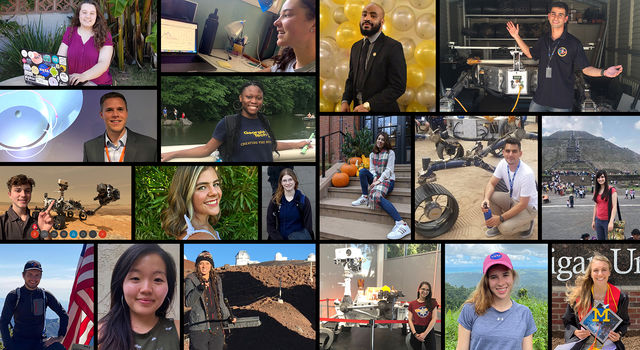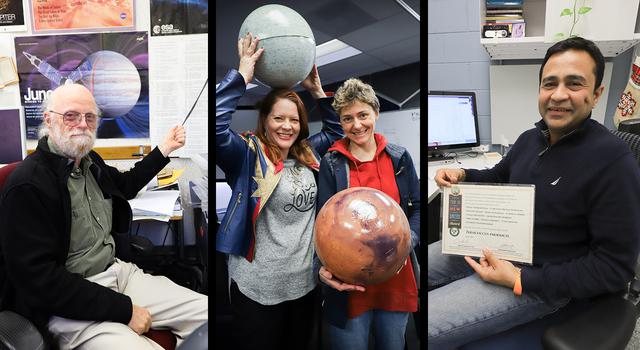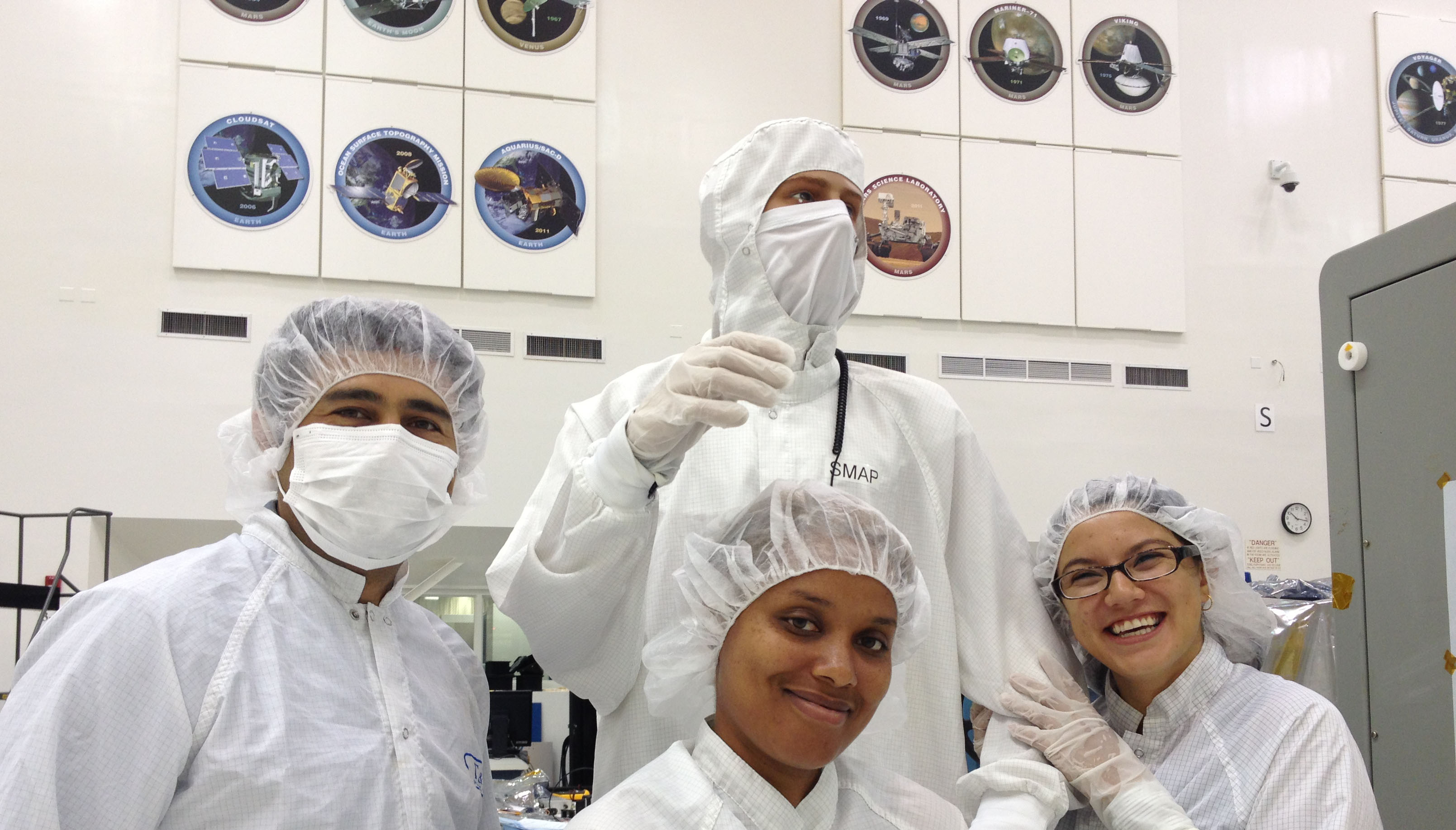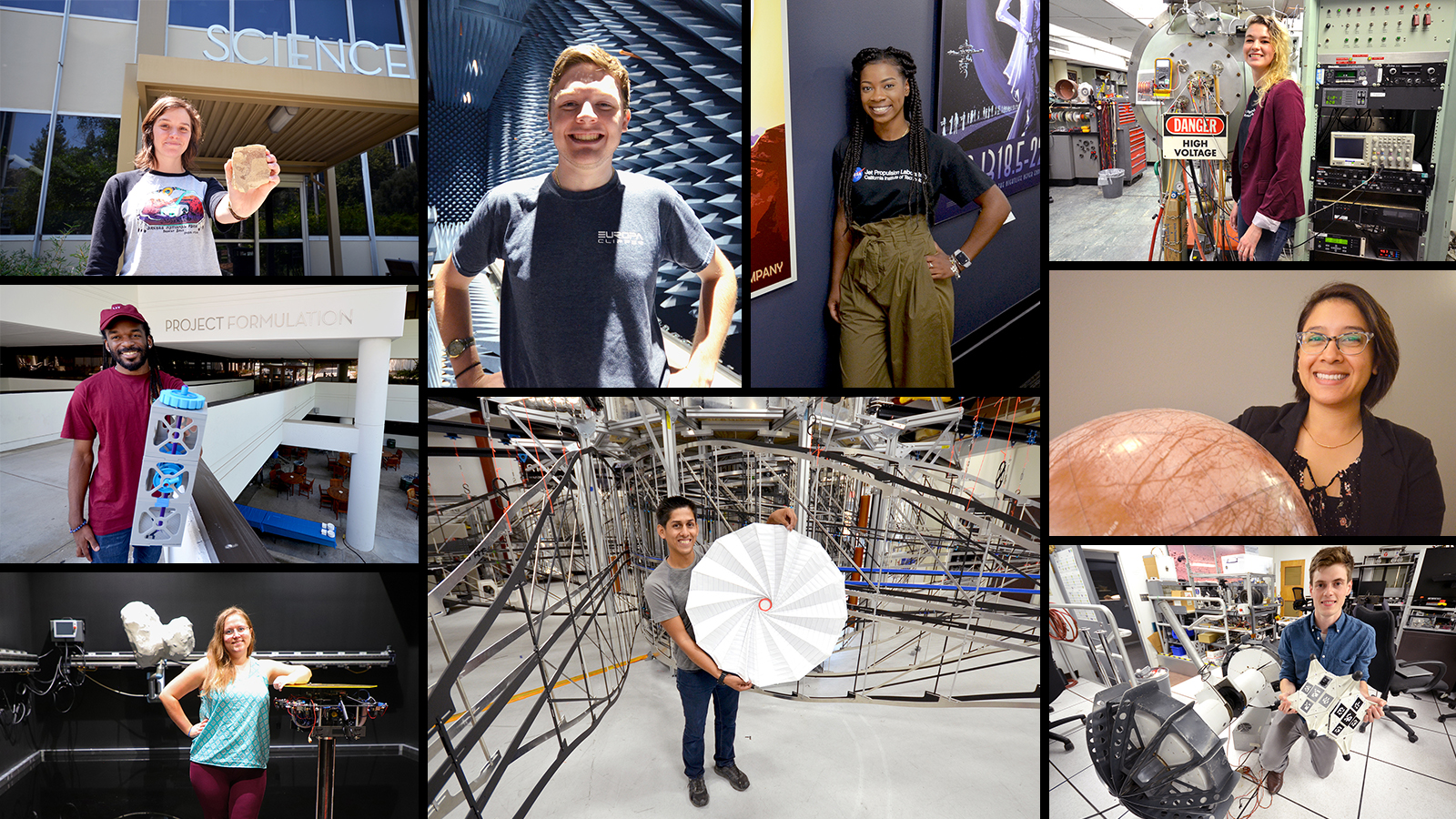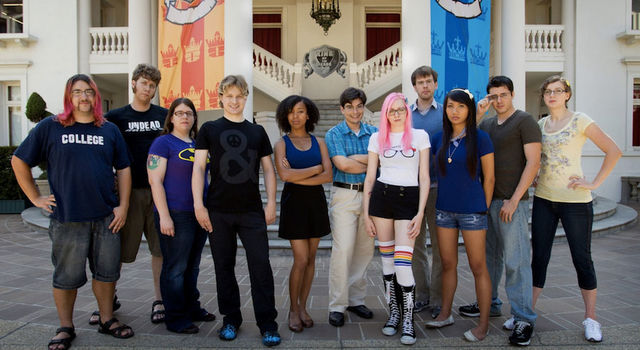Meet JPL Interns | July 23, 2020
JPL Interns Are Working From Home While 'Going the Distance' for Space Exploration
Most years, summertime at NASA's Jet Propulsion Laboratory arrives with an influx of more than 800 interns, raring to play a hands-on role in exploring Earth and space with robotic spacecraft.
Perhaps as exciting as adding NASA to their resumes and working alongside the scientists and engineers they have long admired is the chance to explore the laboratory's smorgasbord of science labs, spacecraft assembly facilities, space simulators, the historic mission control center and a place called the Mars Yard, where engineers test drive Mars rovers.
But this year, as the summer internship season approached with most of JPL's more than 6,000 employees still on mandatory telework, the laboratory – and the students who were offered internships at the Southern California center – had a decision to make.
"We asked the students and the mentors [the employees bringing them in] whether their projects could still be achieved remotely and provide the educational component we consider to be so crucial to these experiences," said Adrian Ponce, deputy section manager of JPL's Education Office, which runs the laboratory's STEM internship programs.
The answer was a resounding yes, which meant the laboratory had just a matter of weeks to create virtual alternatives for every aspect of the internship experience, from accessing specialized software for studying Earth and planetary science to testing and fine-tuning the movements of spacecraft in development and preparing others for launch to attending enrichment activities like science talks and team building events.
“We were able to transition almost all of the interns to aspects of their projects that are telework-compatible. Others agreed to a future start date,” said Ponce, adding that just 2% of the students offered internships declined to proceed or had their projects canceled.
Now, JPL's 600-plus summer interns – some who were part-way through internships when the stay-at-home orders went into effect, others who are returning and many who are first-timers – are getting an extended lesson in the against-the-odds attitude on which the laboratory prides itself.
We wanted to hear about their experiences as JPL's first class of remote interns. What are their routines and home offices like in cities across the country? How have their teams adapted to building spacecraft and doing science remotely? Read a collection of their responses below to learn how JPL interns are finding ways to persevere, whether it's using their engineering skills to fashion homemade desks, getting accustomed to testing spacecraft from 2,000 miles away or working alongside siblings, kids, and pets.
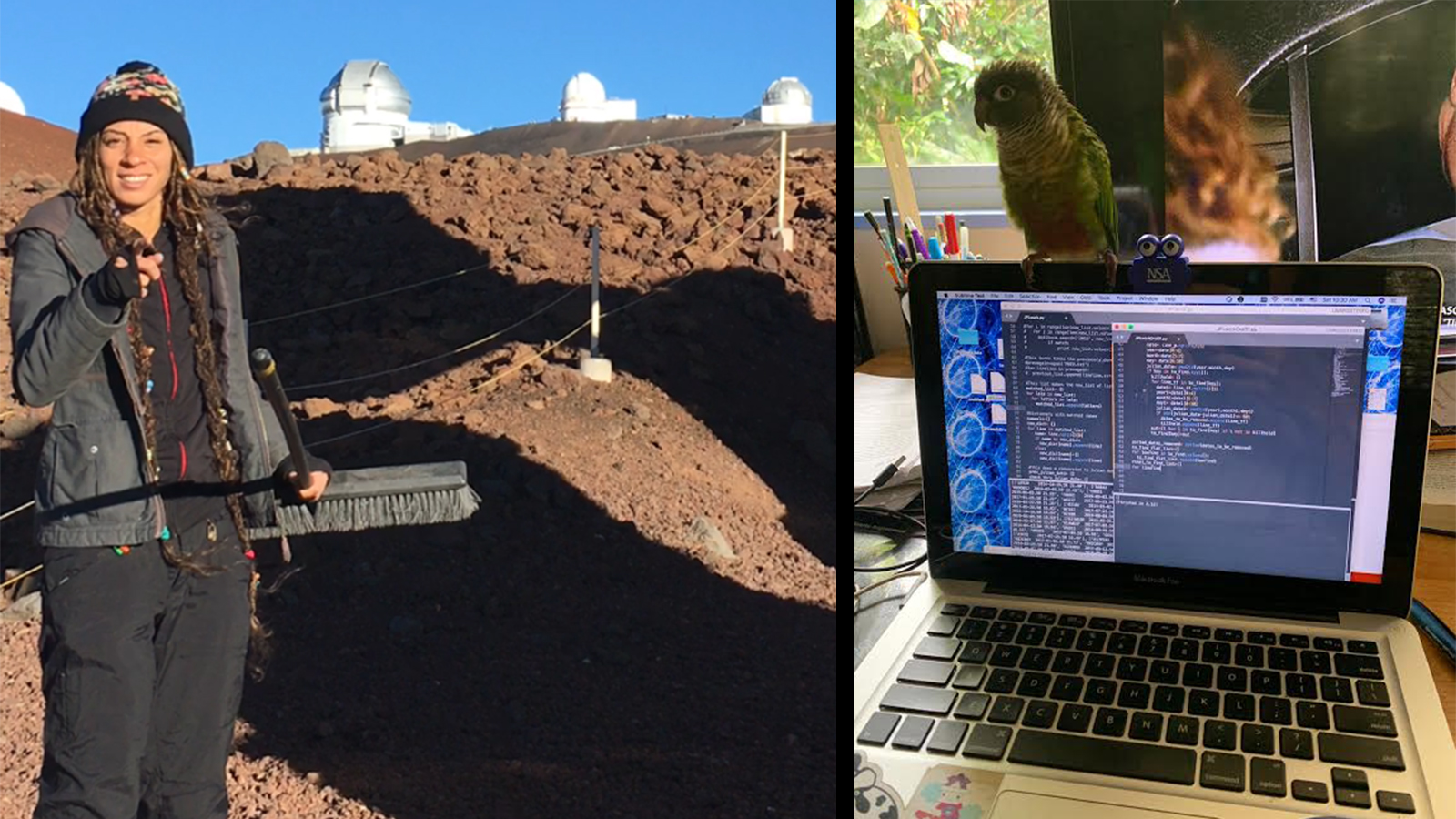
Courtesy of Jennifer Bragg | + Expand image
"I am working with an astronomer on the NEOWISE project, which is an automated system that detects near-Earth objects, such as asteroids. The goal of my project is to identify any objects missed by the automated system and use modeling to learn more about their characteristics. My average day consists of writing scripts in Python to manipulate the NEOWISE data and visually vet that the objects in the images are asteroids and not noise or stars.
My office setup consists of a table with scattered books, papers, and pencils, a laptop, television, a child in the background asking a million questions while I work, and a bird on my shoulder that watches me at times."
– Jennifer Bragg will be studying optics at the University of Arizona as an incoming graduate student starting this August. She is completing her summer internship from Pahoa, Hawaii.

Courtesy of Radina Yanakieva | + Expand image
"I'm helping support the Perseverance Mars rover launch this summer. So far, I have been working remotely, but I'm lucky enough to have the opportunity to go to Pasadena, California, in late July to support the launch from JPL! On launch day, I will be in the testbed, where myself and a few other members of my group will be 'shadowing' the spacecraft. This means that when operators send their commands to the actual spacecraft, when it’s on the launch pad and during its first day or so in space, we'll send the same instructions to the test-bed version. This way, if anything goes wrong, we'll have a high-fidelity simulation ready for debugging.
I have a desk in my bedroom, so my office setup is decent enough. I bought a little whiteboard to write myself notes. As for my average working day, it really depends on what I'm doing. Some days, I'm writing procedures or code, so it's a text editor, a hundred internet tabs, and a messenger to ask my team members questions. Other days, I'm supporting a shift in the test bed, so I'm on a web call with a few other people talking about the test we're doing. Luckily, a large portion of my team's work can be done on our personal computers. The biggest change has been adding the ability to operate the test bed remotely. I'm often amazed that from New York, I can control hardware in California.
I was ecstatic that I was still able to help with the Perseverance Mars rover mission! I spent the second half of 2019 working on launch and cruise testing for the mission, so I'm happy to be able to see it through."
– Radina Yanakieva is an undergraduate student studying aerospace engineering at Georgia Tech and interning from Staten Island, New York.
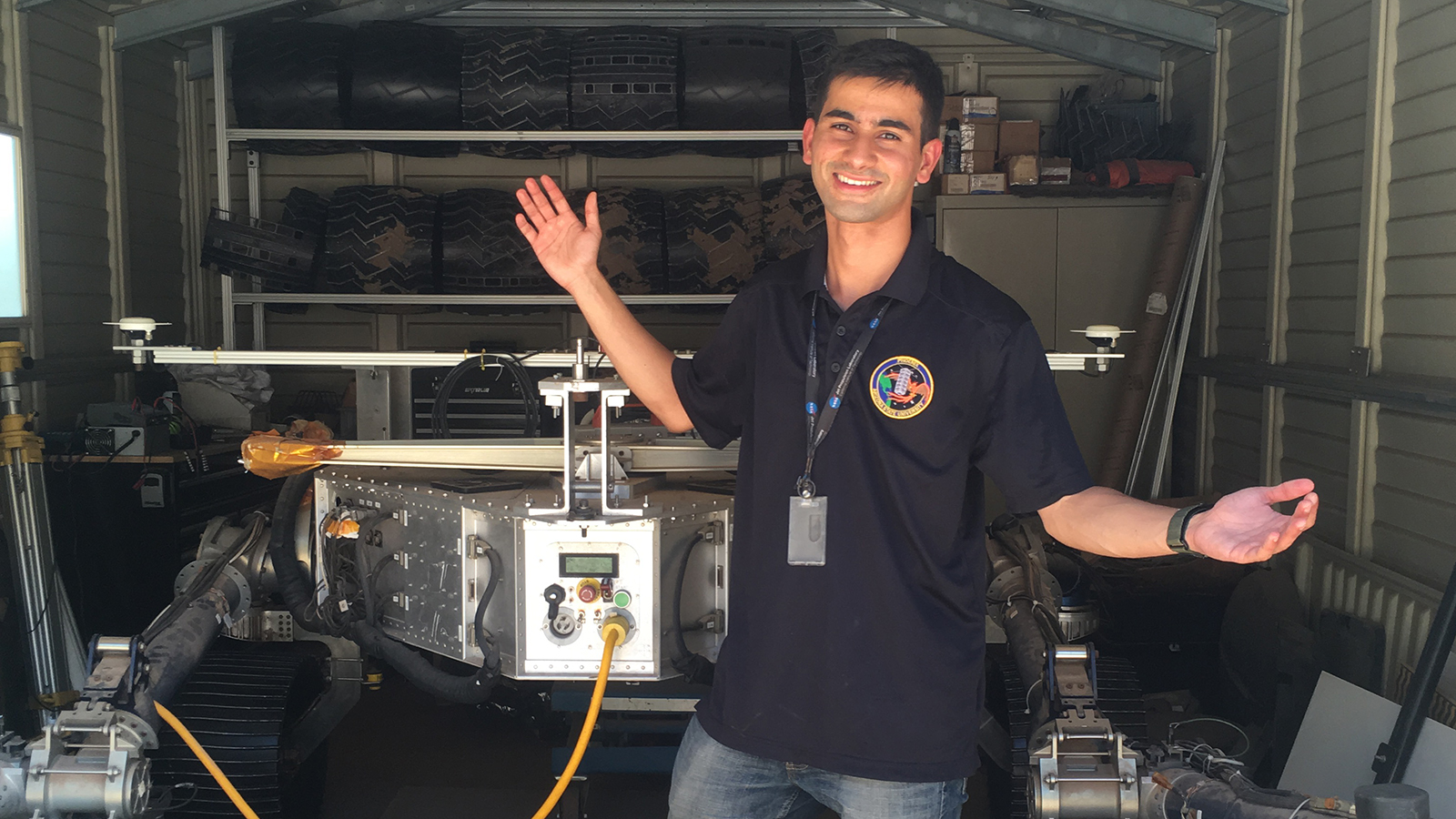
Courtesy of Aditya Khuller | + Expand image
"Our team is using radar data [from the European Space Agency’s Mars Express spacecraft] to find out what lies beneath the large icy deposits on Mars' south pole. My average day consists of analyzing this radar data on my computer to find and map the topography of an older surface that lies below the ice on Mars’ south pole, while my plants look on approvingly.
I was delighted to be offered the chance to work at JPL again. (This is my fourth JPL internship.) Even though it's better to be 'on lab,' it is an honor to get to learn from the coolest and smartest people in the world."
– Aditya Khuller is a graduate student working toward a Ph.D. in planetary science at Arizona State University and interning from Tempe, Arizona.
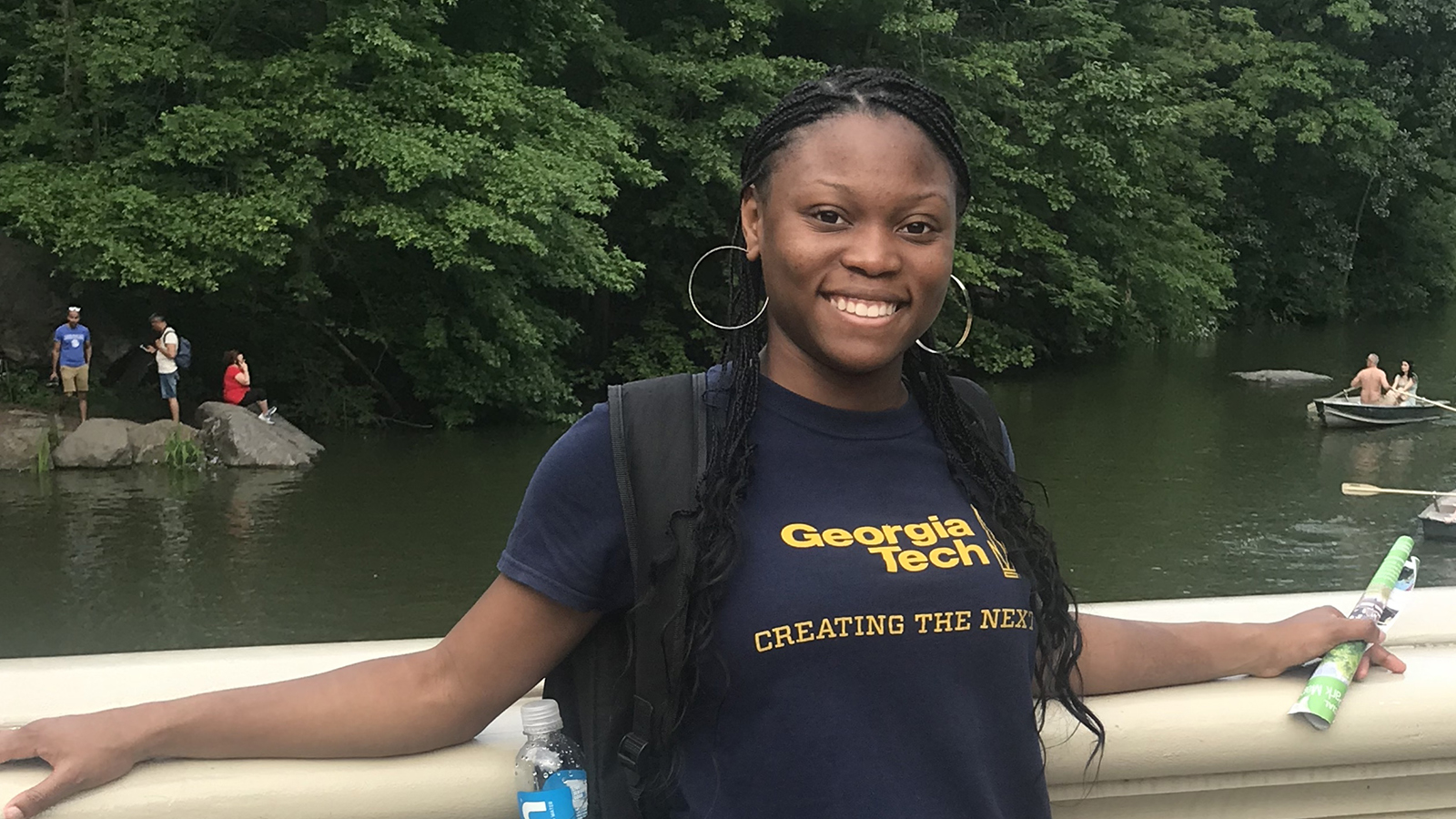
Courtesy of Breanna Ivey | + Expand image
"I am working on the Perseverance Mars rover mission [launching this summer]. As a member of the mobility team, I am testing the rover's auto-navigation behaviors. If given a specific location, flight software should be able to return data about where that location is relative to the rover. My project is to create test cases and develop procedures to verify the data returned by the flight software when this feature is used.
My average day starts with me eating breakfast with my mom who is also working from home. Then, I write a brief plan for my day. Next, I meet with my mentor to discuss any problems and/or updates. I spend the rest of my day at my portable workstation working on code to test the rover's behaviors and analyzing the data from the tests. I have a mini desk that I either set up in my bedroom in front of my Georgia Tech Buzz painting or in the dining room.
If I could visit in person, the first thing I would want to see is the Mars rover engineering model "Scarecrow." I would love to visit the Mars Yard [a simulated Mars environment at JPL] and watch Scarecrow run through different tests. It would be so cool to see a physical representation of the things that I've been working on."
– Breanna Ivey is an undergraduate student studying electrical engineering at the Georgia Institute of Technology and interning from Macon, Georgia.
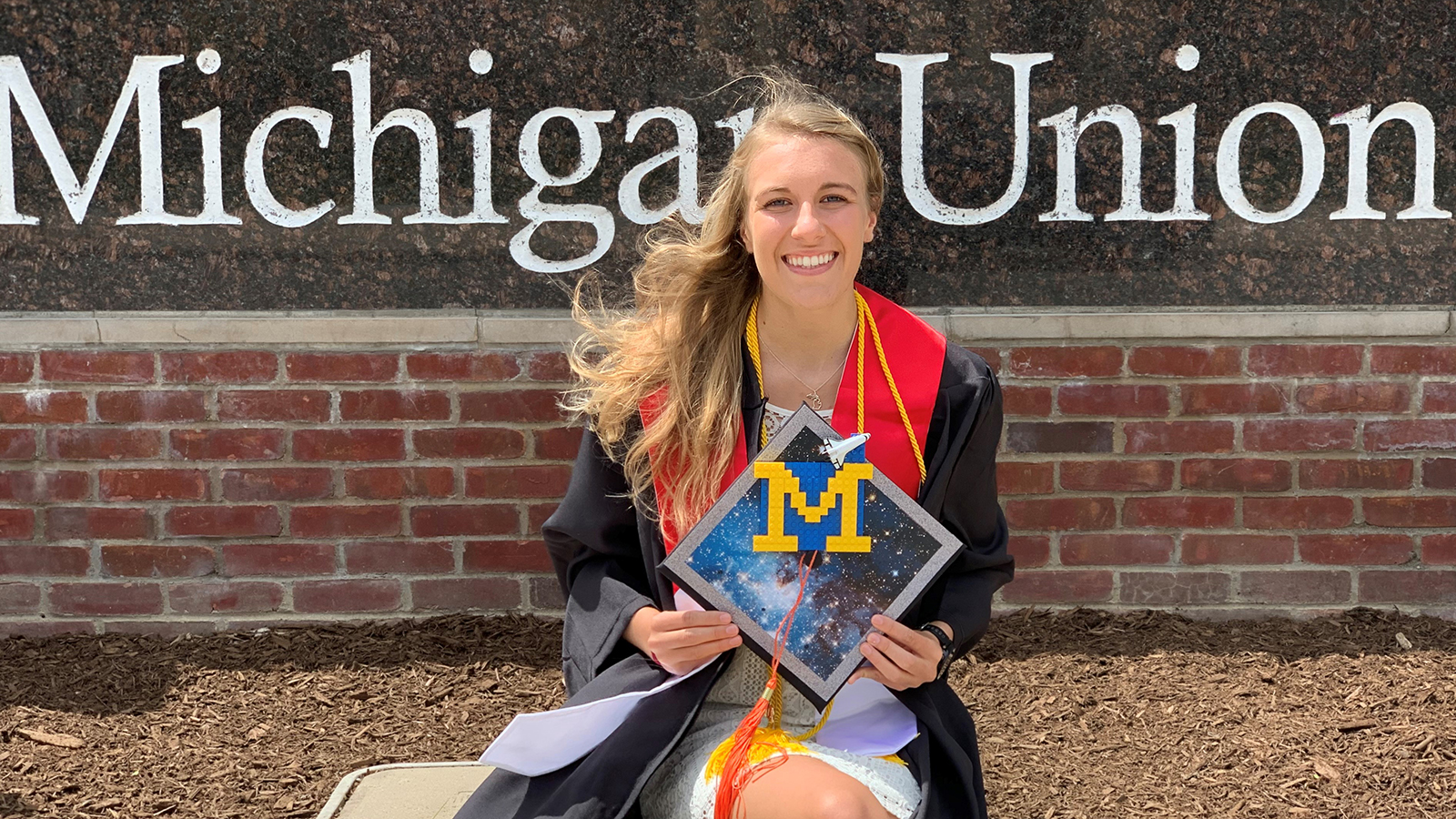
Courtesy of Kaelan Oldani | + Expand image
"I am working on the Psyche mission as a member of the Assembly Test and Launch Operations team, also known as ATLO. (We engineers love our acronyms!) Our goal is to assemble and test the Psyche spacecraft to make sure everything works correctly so that the spacecraft will be able to orbit and study its target, a metal asteroid also called Psyche. Scientists theorize that the asteroid is actually the metal core of what was once another planet. By studying it, we hope to learn more about the formation of Earth.
I always start out my virtual work day by giving my dog a hug, grabbing a cup of coffee and heading up to my family's guest bedroom, which has turned into my office for the summer. On the window sill in my office are a number of space-themed Lego sets including the 'Women of NASA' set, which helps me get into the space-exploration mood! Once I have fueled up on coffee, my brain is ready for launch, and I log in to the JPL virtual network to start writing plans for testing Psyche's propulsion systems. While the ATLO team is working remotely, we are focused on writing test plans and procedures so that they can be ready as soon as the Psyche spacecraft is in the lab for testing. We have a continuous stream of video calls set up throughout the week to meet virtually with the teams helping to build the spacecraft."
– Kaelan Oldani is a master's student studying aerospace engineering at the University of Michigan and interning from Ann Arbor, Michigan. She recently accepted a full-time position at JPL and is starting in early 2021.
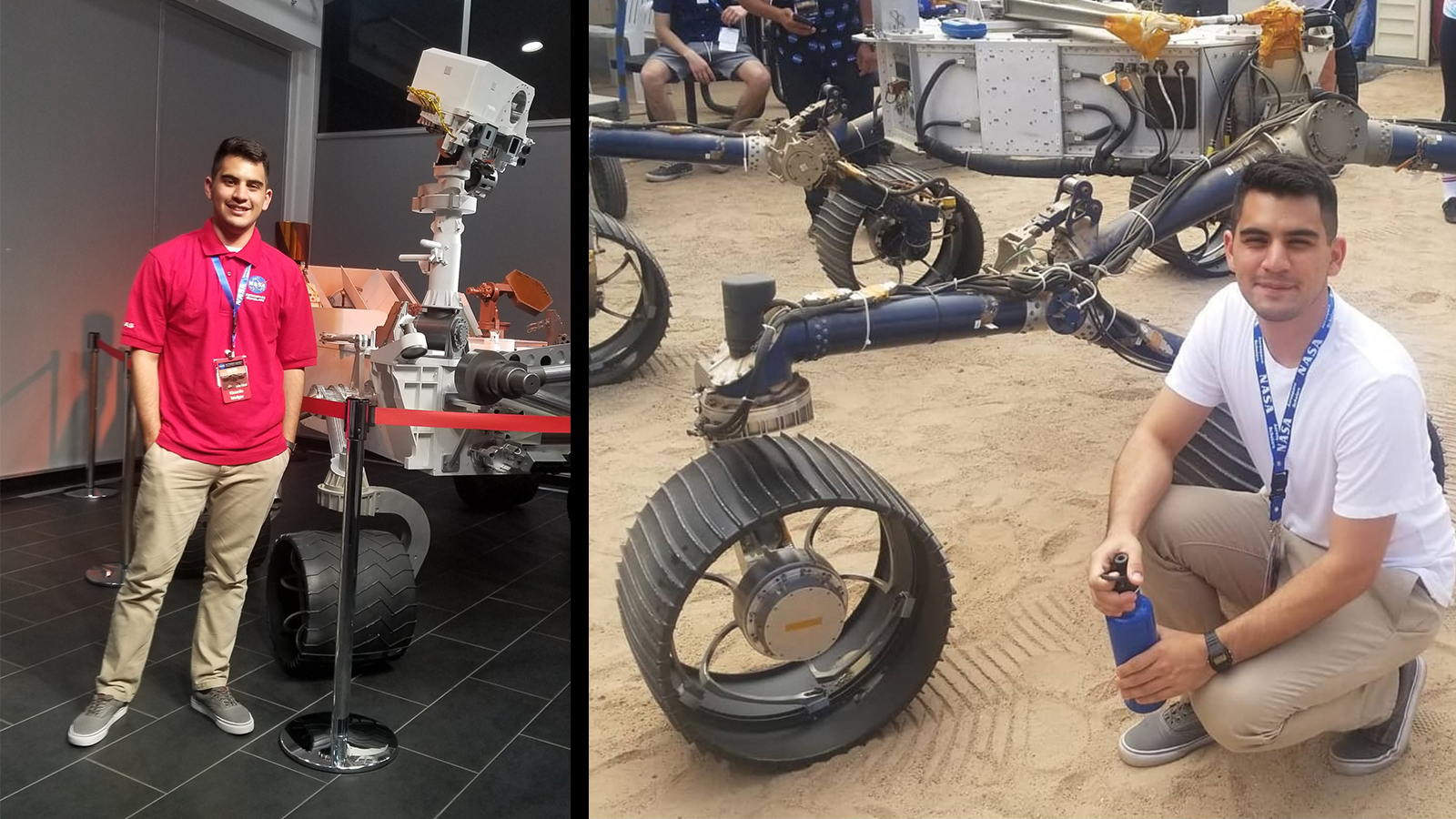
Courtesy of Ricardo Isai Melgar | + Expand image
"NASA's Deep Space Network is a system of antennas positioned around the world – in Australia, Spain, and Goldstone, California – that's used to communicate with spacecraft. My internship is working on a risk assessment of the hydraulic system for the 70-meter antenna at the Goldstone facility. The hydraulic system is what allows the antenna and dish surrounding it to move so it can accurately track spacecraft in flight. The ultimate goal of the work is to make sure the antenna's hydraulic systems meet NASA standards.
My average day starts by getting ready for work (morning routine), accessing my work computer through a virtual interface and talking with my mentor on [our collaboration tool]. Then, I dive into work, researching hydraulic schematics, JPL technical drawings of the antenna, and NASA standards, and adding to a huge spreadsheet that I use to track every component of the antenna's hydraulic system. Currently, I'm tracking every flexible hydraulic fluid hose on the system and figuring out what dangers a failure of the hose could have on personnel and the mission."
– Ricardo Isai Melgar is an undergraduate student studying mechanical engineering at East Los Angeles College and interning from Los Angeles.
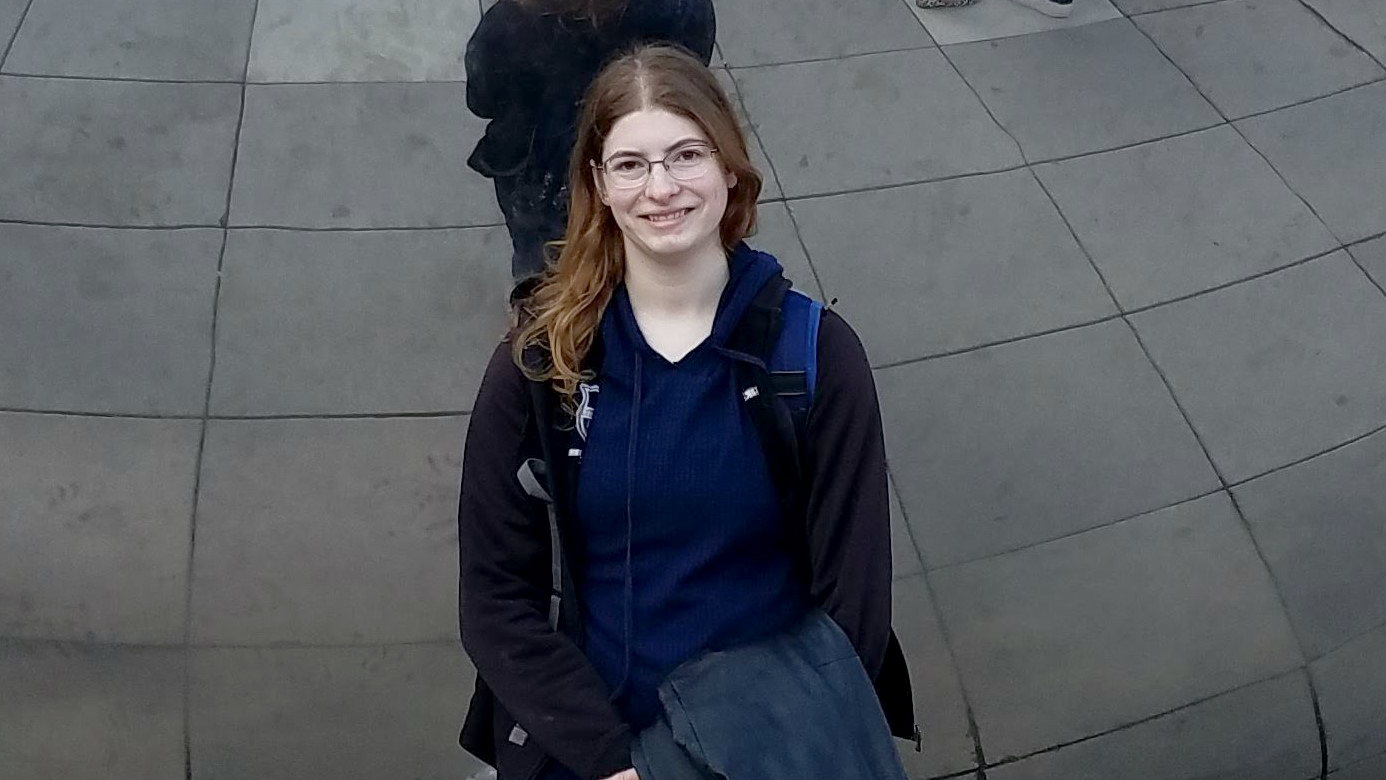
Courtesy of Susanna Eschbach | + Expand image
"My project this summer is to develop a network of carbon-dioxide sensors to be used aboard the International Space Station for monitoring the levels of carbon dioxide that crewmembers experience.
My 'office setup' is actually just a board across the end of my bed balanced on the other side by a small dresser that I pull into the middle of the room every day so that I can sit and have a hard surface to work on.
At first I wasn't sure if I was interested in doing a virtual engineering internship. How would that even work? But after talking to my family, I decided to accept. Online or in person, getting to work at JPL is still a really cool opportunity."
– Susanna Eschbach is an undergraduate student studying electrical and computer engineering at Northern Illinois University and interning from DeKalb, Illinois.
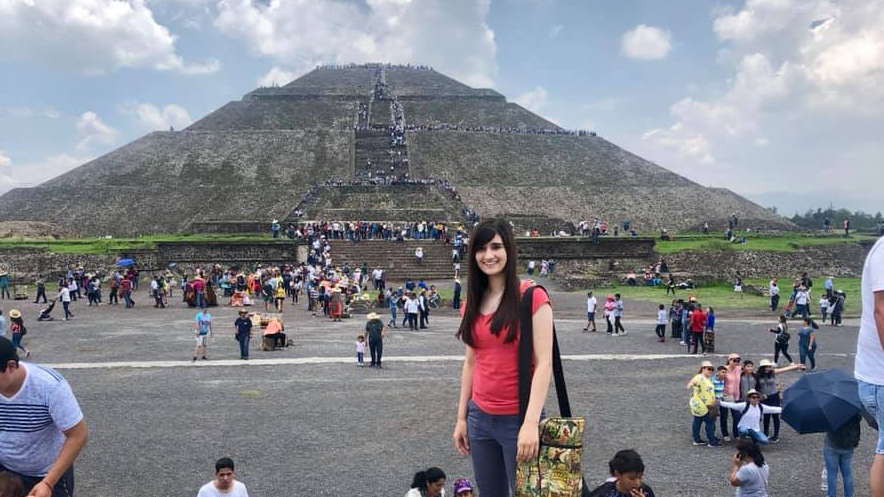
Courtesy of Izzie Torres | + Expand image
"I'm planning test procedures for the Europa Clipper mission [which is designed to make flybys of Jupiter's moon Europa]. The end goal is to create a list of tests we can perform that will prove that the spacecraft meets its requirements and works as a whole system.
I was very excited when I got the offer to do a virtual internship at JPL. My internship was originally supposed to be with the Perseverance Mars rover mission, but it required too much in-person work, so I was moved to the Europa Clipper project. While I had been looking forward to working on a project that was going to be launching so soon, Jupiter's moon Europa has always captured my imagination because of the ocean under its surface. It was an added bonus to know I had an internship secured for the summer."
– Izzie Torres is an undergraduate student studying aerospace engineering and management at MIT and interning from Seattle.
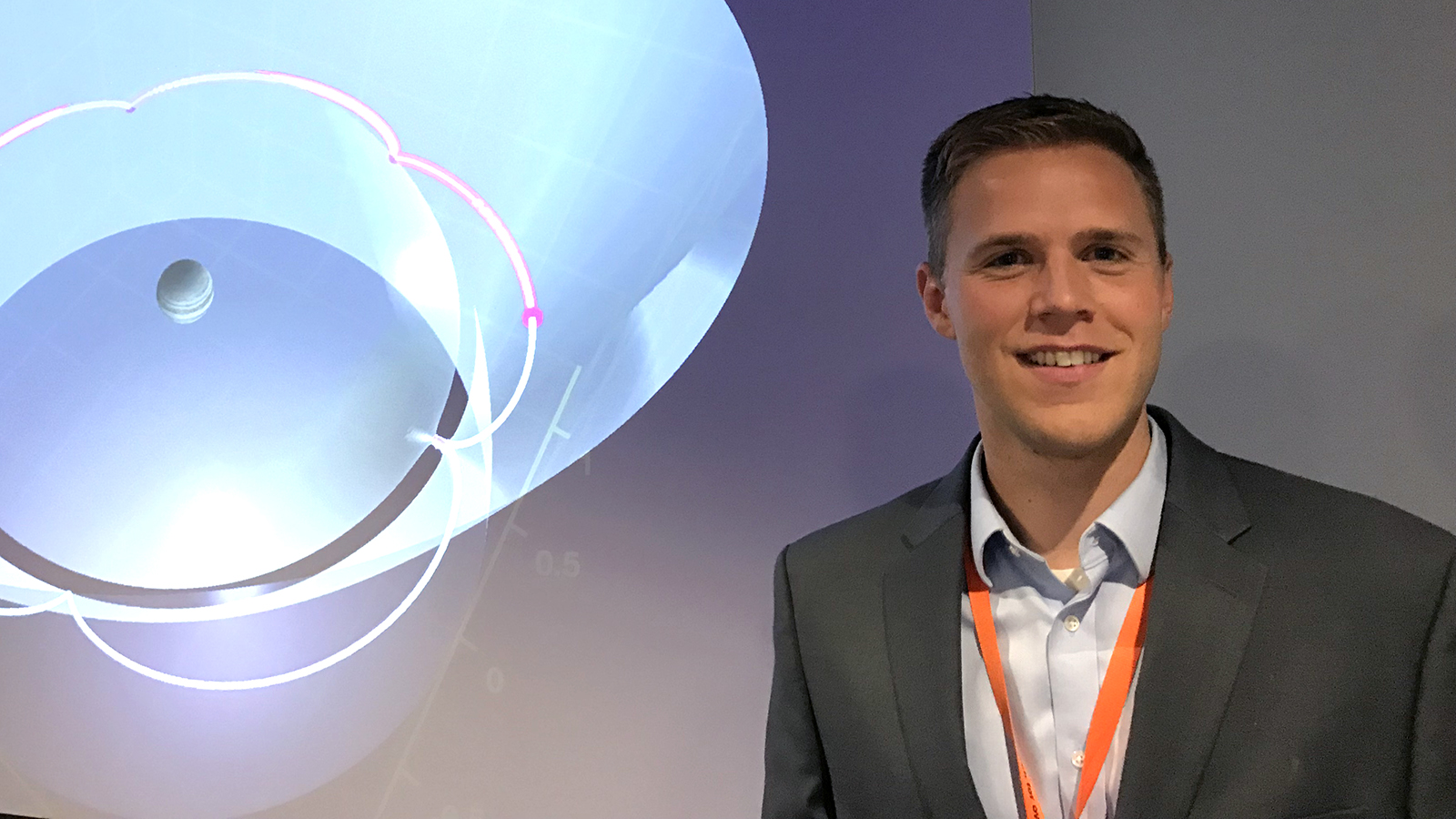
Courtesy of Jared Blanchard | + Expand image
"I am investigating potential spacecraft trajectories to reach the water worlds orbiting the outer planets, specifically Jupiter's moon Europa. If you take both Jupiter and Europa into account, their gravitational force fields combine to allow for some incredibly fuel-efficient maneuvers between the two. The ultimate goal is to make it easier for mission designers to use these low-energy trajectories to develop mission plans that use very little fuel.
I'm not a gamer, but I just got a new gaming laptop because it has a nice graphics processing unit, or GPU. During my internship at JPL last summer, we used several GPUs and a supercomputer to make our trajectory computations 10,000 times faster! We plan to use the GPU to speed up my work this summer as well. I have my laptop connected to a second monitor up in the loft of the cabin where my wife and I are staying. We just had a baby two months ago, so I have to make the most of the quiet times when he's napping!"
– Jared Blanchard is a graduate student working toward a Ph.D. in aeronautics and astronautics at Stanford University.
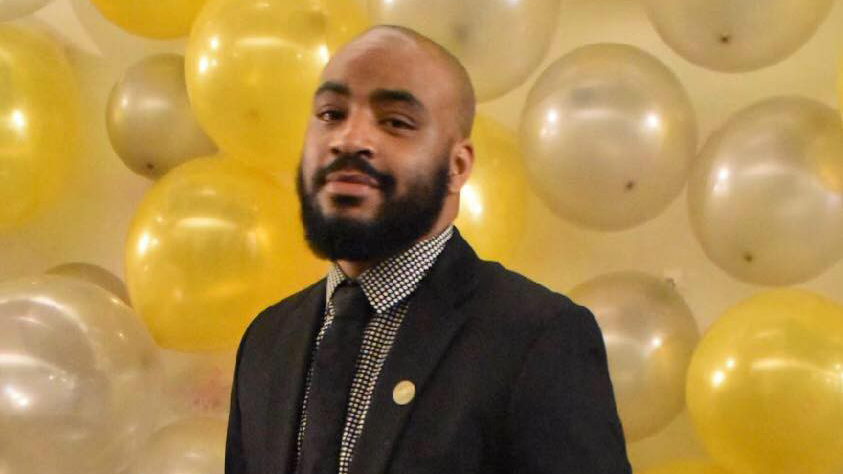
Courtesy of Yohn I. Ellis Jr. | + Expand image
"I'm doing a theory-based project on the topic of nanotechnology under the mentorship of Mohammad Ashtijou and Eric Perez.
I vividly remember being infatuated with NASA as a youth, so much so that my parents ordered me a pamphlet from Space Center Houston with posters and stickers explaining all of the cool things happening across NASA. I will never forget when I was able to visit Space Center Houston on spring break in 2009. It was by far the most amazing thing I have ever witnessed as a youth. When I was offered the internship at JPL, I was excited, challenged, and motivated. There is a great deal of respect that comes with being an NASA intern, and I look forward to furthering my experiences.
But the challenges are prevalent, too. Unfortunately, the internship is completely virtual and there are limitations to my experience. It is hard working at home with the multiple personalities in my family. I love them, but have you attempted to conduct research with a surround system of romantic comedies playing in the living room, war video games blasting grenades, and the sweet voice of your grandmother asking for help getting pans from the top shelf?"
– Yohn I. Ellis Jr. is a graduate student studying electrical engineering at Prairie View A&M University and interning from Houston.
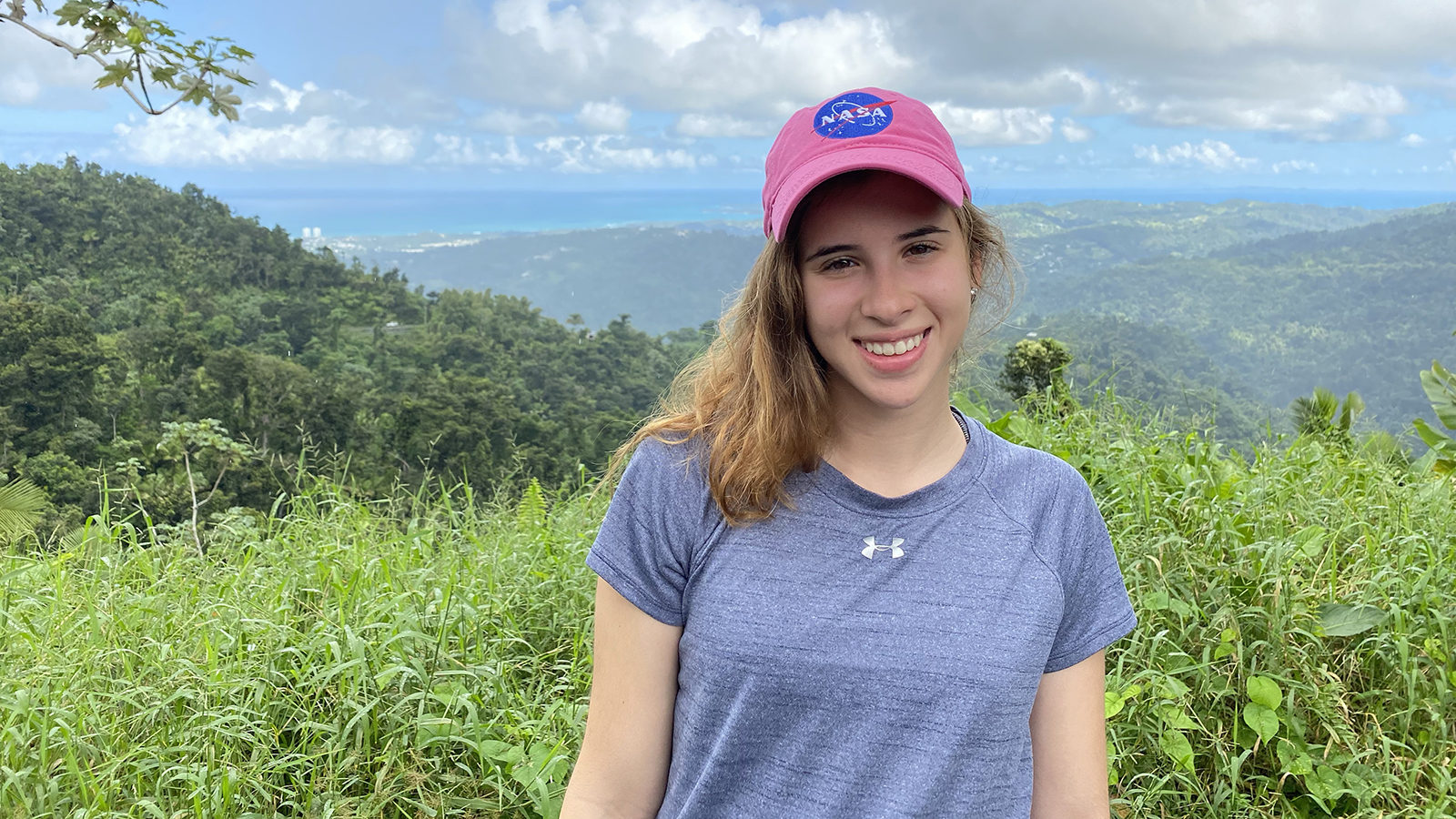
Courtesy of Mina Cezairli | + Expand image
"This summer, I am supporting the proposal for a small satellite mission concept called Cupid’s Arrow. Cupid’s Arrow would be a small probe designed to fly through Venus’ atmosphere and collect samples. The ultimate goal of the project is to understand the “origin story” of Venus' atmosphere and how, despite their comparable sizes, Earth and Venus evolved so differently geologically, with the former being the habitable, friendly planet that we call home and the latter being the hottest planet in our solar system with a mainly carbon dioxide atmosphere.
While ordinary JPL meetings include discussions of space probes, rockets, and visiting other planets, my working day rarely involves leaving my desk. Because all of my work can be done on my computer, I have a pretty simple office setup: a desk, my computer, and a wall full of posters of Earth and the Solar System. An average day is usually a combination of data analysis, reading and learning about Venus, and a number of web meetings. The team has several different time zones represented, so a morning meeting in Pacific time accommodates all of Pacific, Eastern and European time zones that exist within the working hours of the team."
– Mina Cezairli is an undergraduate student studying mechanical engineering at Yale University and is interning from New Haven, Connecticut.

Courtesy of Izabella Zamora | + Expand image
“I'm characterizing the genetic signatures of heat-resistant bacteria. The goal is to improve the techniques we use to sterilize spacecraft to prevent them from contaminating other worlds or bringing contaminants back to Earth. Specifically, I'm working to refine the amount of time spacecraft need to spend getting blasted by dry heat as a sanitation method.
"As someone who has a biology-lab heavy internship, I was quite skeptical of how an online internship would work. There was originally supposed to be lab work, but I think the project took an interesting turn into research and computational biology. It has been a really cool intersection to explore, and I have gained a deeper understanding of the math and analysis involved in addition to the biology concepts."
– Izabella Zamora is an undergraduate student studying biology and computer science at the Massachusetts Institute of Technology and interning from Brimfield, Massachusetts.
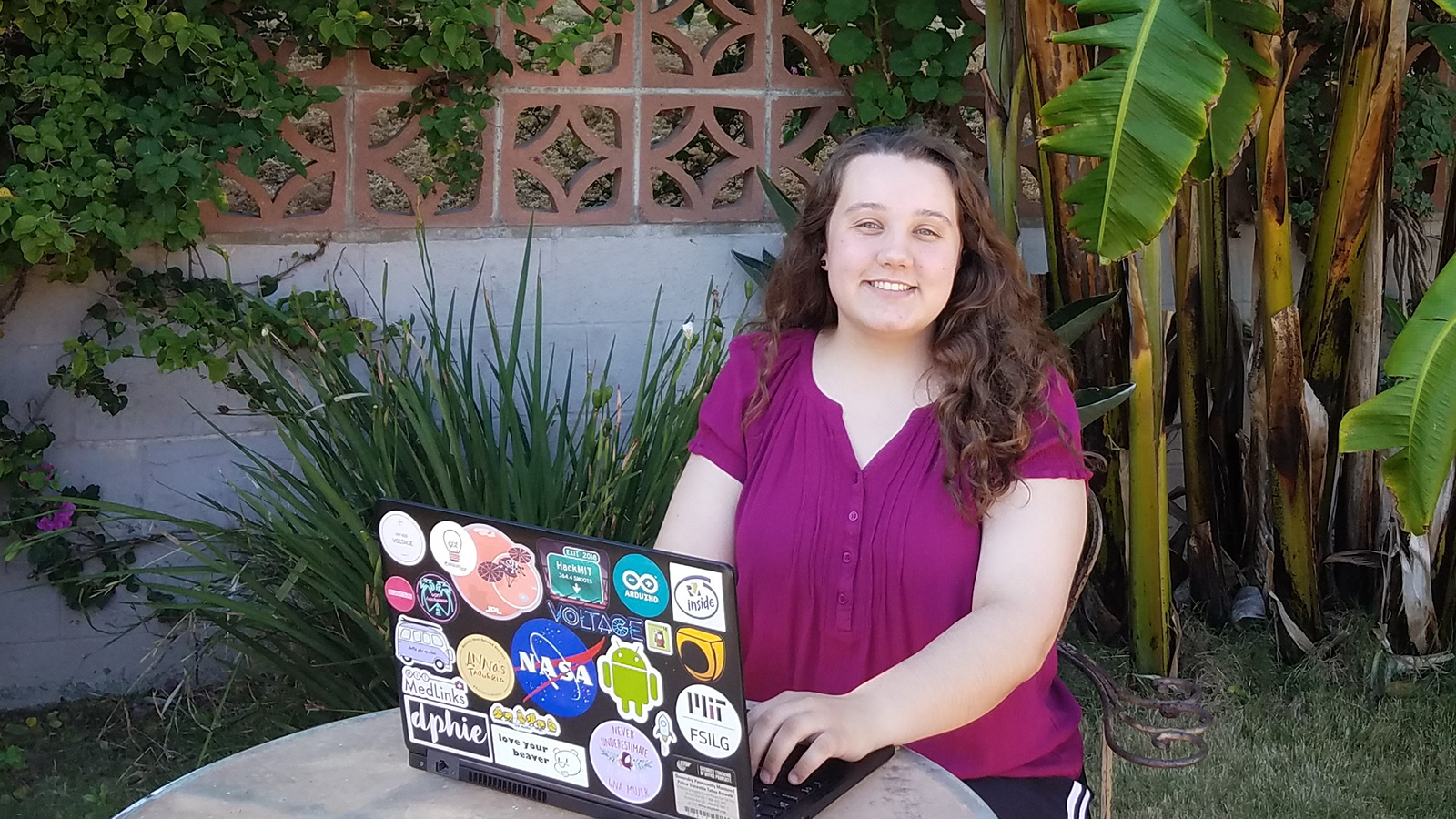
Courtesy of Leilani Trautman | + Expand image
"I am working on the engineering operations team for the Perseverance Mars rover. After the rover lands on Mars, it will send daily status updates. Every day, an engineer at JPL will need to make sure that the status update looks healthy so that the rover can continue its mission. I am writing code to make that process a lot faster for the engineers.
When I was offered the internship back in November, I thought I would be working on hardware for the rover. Once the COVID-19 crisis began ramping up and I saw many of my friends' internships get cancelled or shortened, I was worried that the same would happen to me. One day, I got a call letting me know that my previous internship wouldn't be possible but that there was an opportunity to work on a different team. I was so grateful to have the opportunity to retain my internship at JPL and get the chance to work with my mentor, Farah Alibay, who was once a JPL intern herself."
– Leilani Trautman is an undergraduate student studying electrical engineering and computer science at MIT and interning from San Diego, California.
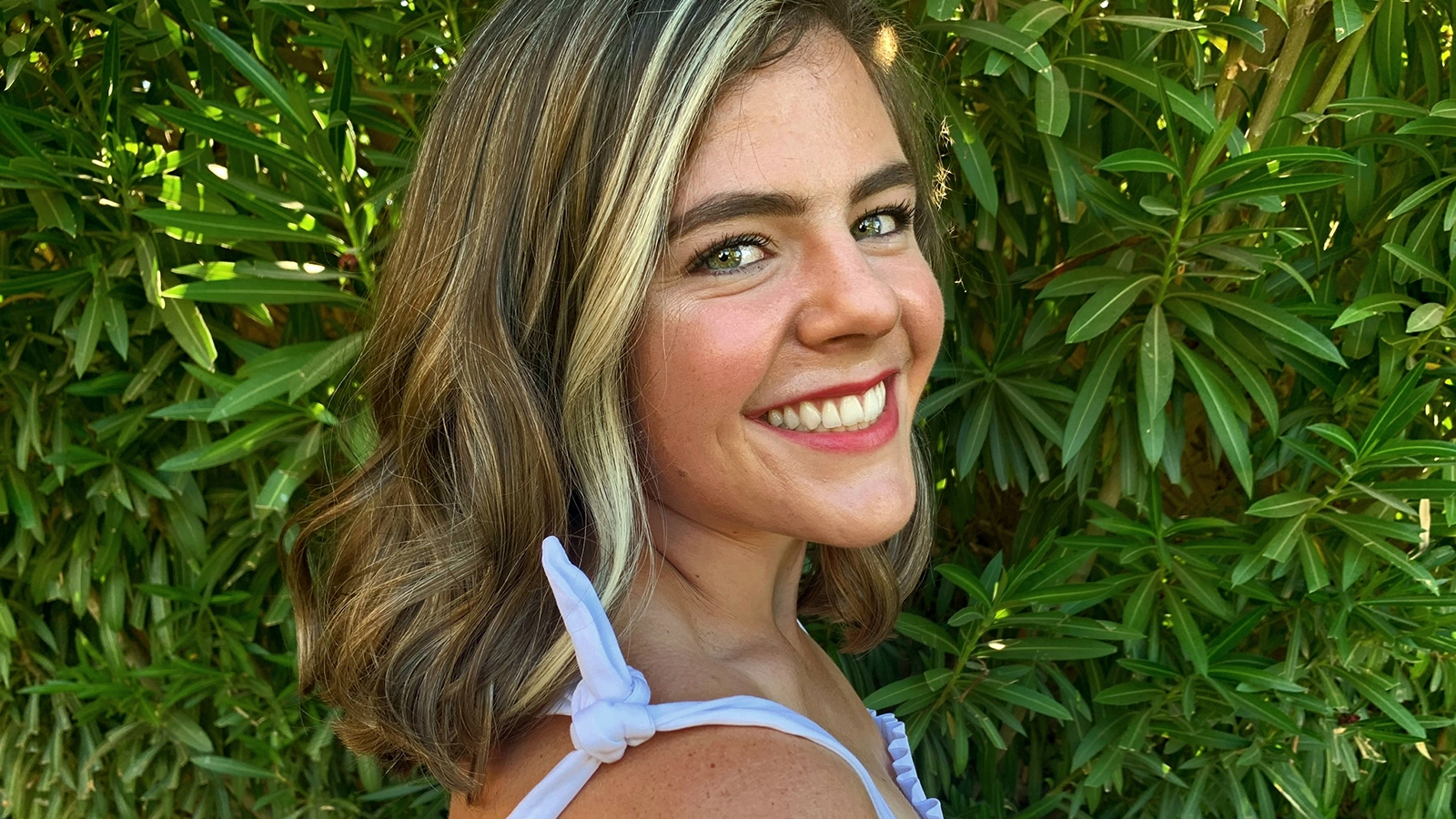
Courtesy of Kathryn Chamberlin | + Expand image
"I am working on electronics for the coronagraph instrument that will fly aboard the Nancy Grace Roman Space Telescope. The Roman Space Telescope will study dark energy, dark matter, and exoplanets [planets outside our solar system]. The science instrument I'm working on will be used to image exoplanets. It's also serving as a technology demonstration to advance future coronagraphs [which are instruments designed to observe objects close to bright stars].
I was both nervous and excited to have a virtual internship. I’m a returning intern, continuing my work on the coronagraph instrument. I absolutely love my work and my project at JPL, so I was really looking forward to another internship. Since I’m working with the same group, I was relieved that I already knew my team, but nervous about how I would connect with my team, ask questions, and meet other 'JPLers.' But I think my team is just as effective working virtually as we were when working 'on lab.' My mentor and I have even figured out how to test hardware virtually by video calling the engineer in the lab and connecting remotely into the lab computer."
– Kathryn Chamberlin is an undergraduate student studying electrical engineering at Arizona State University and interning from Phoenix.

Courtesy of Daniel Stover | + Expand image
"I am working on the flight system for the Perseverance Mars rover. The first half of my internship was spent learning the rules of the road for the entire flight system. My first task was updating command-line Python scripts, which help unpack the data that is received from the rover. After that, I moved on to testing a part of the flight software that manages which mechanisms and instruments the spacecraft can use at a certain time. I have been so grateful to contribute to the Perseverance Mars rover project, especially during the summer that it launches!
I have always been one to be happy with all the opportunities I am granted, but I do have to say it was hard to come to the realization that I would not be able to step foot on the JPL campus. However, I was truly grateful to receive this opportunity, and I have been so delighted to see the JPL spirit translate to the online video chats and communication channels. It's definitely the amazing people who make JPL into the place that everybody admires. Most important, I would like to thank my mentor, Jessica Samuels, for taking the time to meet with me every day and show me the true compassion and inspiration of the engineers at JPL."
– Daniel Stover is an undergraduate student studying electrical and computer engineering at Virginia Tech and interning from Leesburg, Virginia.
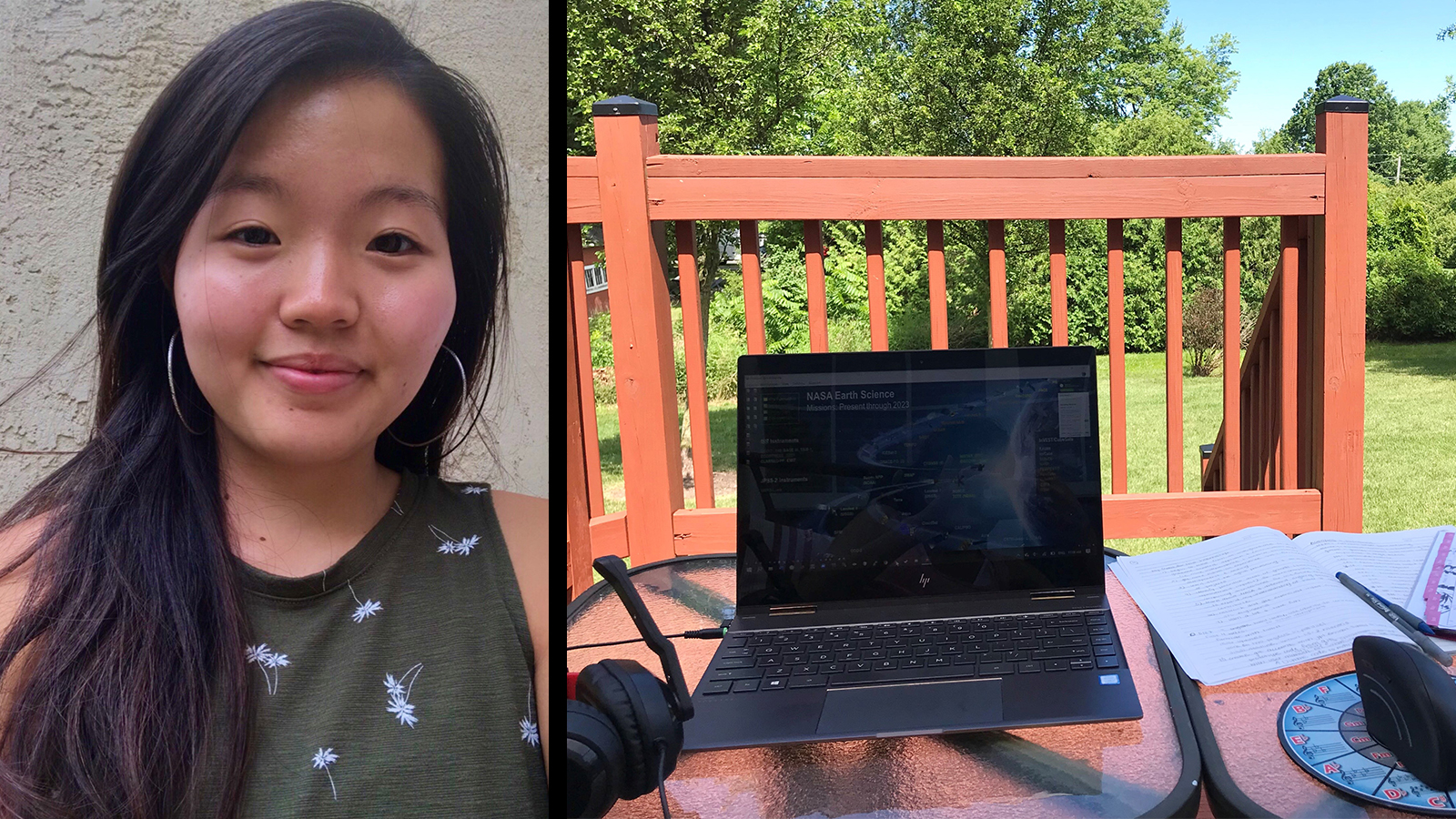
Courtesy of Sophia Yoo | + Expand image
"I'm working on a project called the Multi-Angle Imager for Aerosols, or MAIA. It's an instrument that will go into lower Earth orbit and collect images of particulate matter to learn about air pollution and its effects on health. I'm programming some of the software used to control the instrument's electronics. I'm also testing the simulated interface used to communicate with the instrument.
I was ecstatic to still have my internship! I'm very blessed to be able to do all my work remotely. It has sometimes proven to be a challenge when I find myself more than four layers deep in virtual environments. And it can be confusing to program hardware on the West Coast with software that I wrote all the way over here on the East Coast. However, I've learned so much and am surprised by and grateful for the meaningful relationships I've already built."
– Sophia Yoo is an incoming graduate student studying electrical and computer engineering at Princeton University and is interning from Souderton, Pennsylvania.
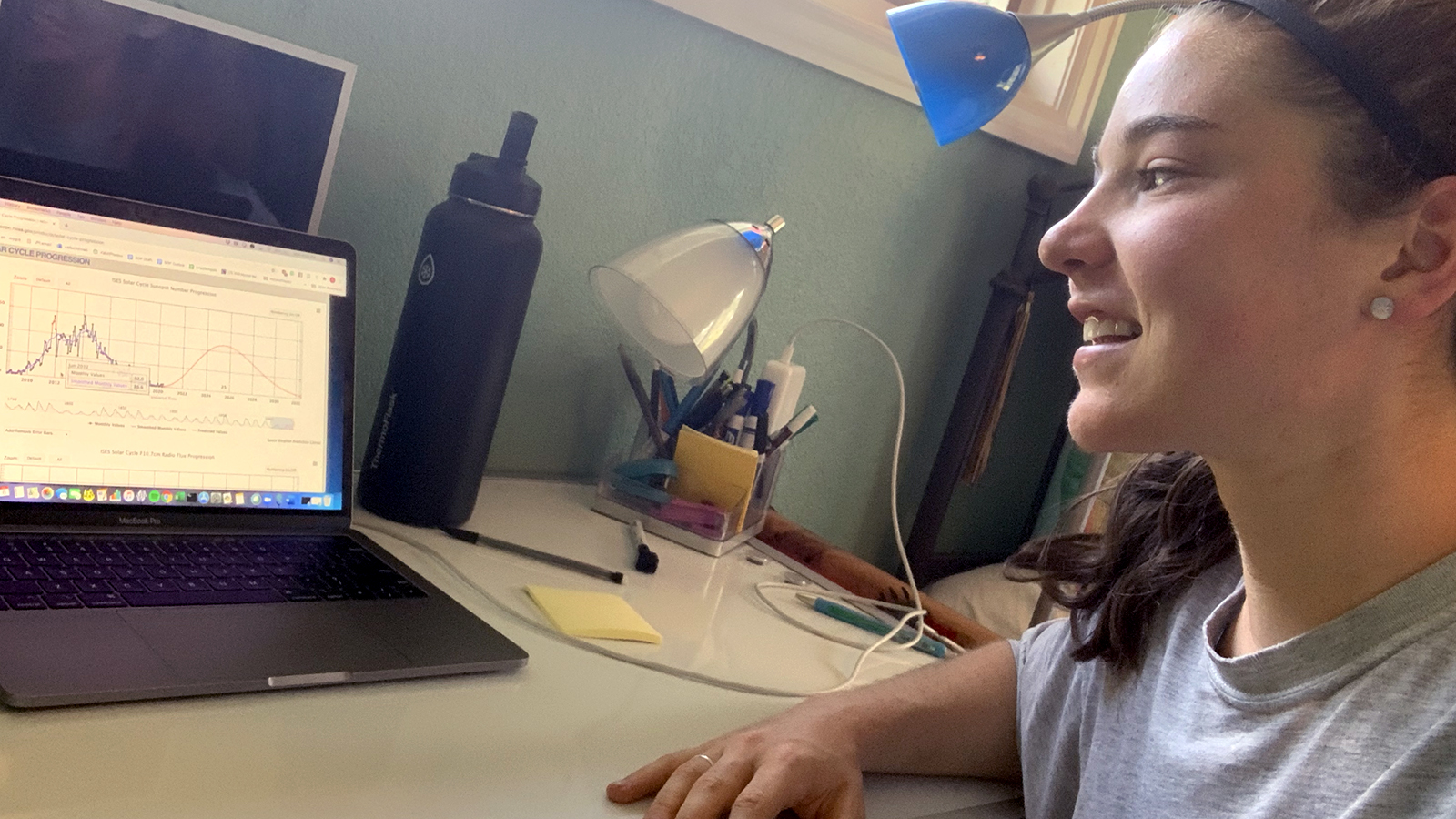
Courtesy of Natalie Maus | + Expand image
"My summer research project is focused on using machine-learning algorithms to make predictions about the density of electrons in Earth’s ionosphere [a region of the planet's upper atmosphere]. Our work seeks to allow scientists to forecast this electron density, as it has important impacts on things such as GPS positioning and aircraft navigation.
Despite the strangeness of working remotely, I have learned a ton about the research process and what it is like to be part of a real research team. Working alongside my mentors to adapt to the unique challenges of working remotely has also been educational. In research, and in life, there will always be new and unforeseen problems and challenges. This extreme circumstance is valuable in that it teaches us interns the importance of creative problem solving, adaptability, and making the most out of the situation we are given."
– Natalie Maus is an undergraduate student studying astrophysics and computer science at Colby College and interning from Evergreen, Colorado.
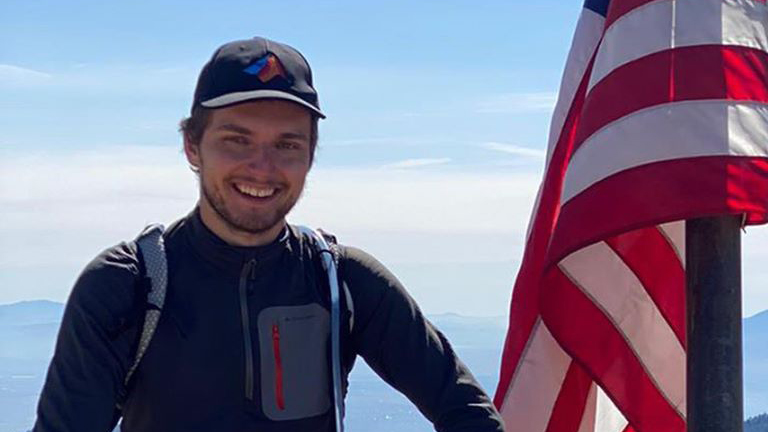
Courtesy of Lucas Lange | + Expand image
"I have two projects at JPL. My first project focuses on the Europa Clipper mission [designed to make flybys of Jupiter's moon Europa]. I study how the complex topography on the icy moon influences the temperature of the surface. This work is crucial to detect 'hot spots,' which are areas the mission (and future missions) aim to study because they might correspond to regions that could support life! My other work consists of studying frost on Mars and whether it indicates the presence of water-ice below the surface.
JPL and NASA interns are connected through social networks, and it's impressive to see the diversity. Some talks are given by 'JPLers' who make themselves available to answer questions. When I came to JPL, I expected to meet superheroes. This wish has been entirely fulfilled. Working remotely doesn't mean working alone. On the contrary, I think it increases our connections and solidarity."
– Lucas Lange is an undergraduate student studying aerospace engineering and planetary science at ISAE-SUPAERO [aerospace institute in France] and interning from Pasadena, California.
Explore JPL’s summer and year-round internship programs and apply at: jpl.nasa.gov/intern
Career opportunities in STEM and beyond can be found online at jpl.jobs. Learn more about careers and life at JPL on LinkedIn and by following @nasajplcareers on Instagram.
The laboratory’s STEM internship and fellowship programs are managed by the JPL Education Office. Extending the NASA Office of STEM Engagement’s reach, JPL Education seeks to create the next generation of scientists, engineers, technologists and space explorers by supporting educators and bringing the excitement of NASA missions and science to learners of all ages.
TAGS: Higher Education, Internships, STEM, College Students, Virtual Internships, Telework, Mars 2020 interns, Mars 2020, Perseverance, DSN, Deep Space Network, Mars, Asteroids, NEOWISE, Science, Technology, Engineering, Computer Science, Psyche, International Space Station, ISS, Europa, Jupiter, Europa Clipper, trajectory, nanotechnology, Cupid's Arrow, Proposal, Venus, Planetary Protection, Biology, Nancy Grace Roman Space Telescope, Dark Matter, Exoplanets, Multi-Angle Imager for Aerosols, MAIA, Earth, Earth science, air pollution, Hispanic Heritage Month, Black History Month, Asian Pacific American Heritage Month, Earth Science, Earth, Climate Change, Sea Level Rise
Edu News | January 24, 2020
Mentors Point the Way to STEM for Interns at NASA-JPL
Each year, 1,000 students come to NASA's Jet Propulsion Laboratory for internships at the place where space robots are born and science is made. Their projects span the STEM spectrum, from engineering the next Mars rover to designing virtual-reality interfaces to studying storms on Jupiter and the possibility of life on other planets. But the opportunity for students to "dare mighty things" at JPL wouldn't exist without the people who bring them to the Laboratory in the first place – the people known as mentors.
A community of about 500 scientists, engineers, technologists and others serve as mentors to students annually as part of the internship programs managed by the JPL Education Office. Their title as mentors speaks to the expansiveness of their role, which isn't just about generating opportunities for students, but also guiding and shaping their careers.
"Mentors are at the core of JPL's mission, pushing the frontiers of space exploration while also guiding the next generation of explorers," says Adrian Ponce, who leads the team that manages JPL's internship programs. "They are an essential part of the career pipeline for future innovators who will inspire and enable JPL missions and science."
Planetary scientist Glenn Orton has been bringing students to JPL for internships studying the atmospheres of planets like Jupiter and Saturn since 1985. He keeps a list of their names and the year they interned with him pinned to his office wall in case he's contacted as a reference. The single-spaced names take up 10 sheets of paper, and he hasn't even added the names of the students he's brought in since just last year.
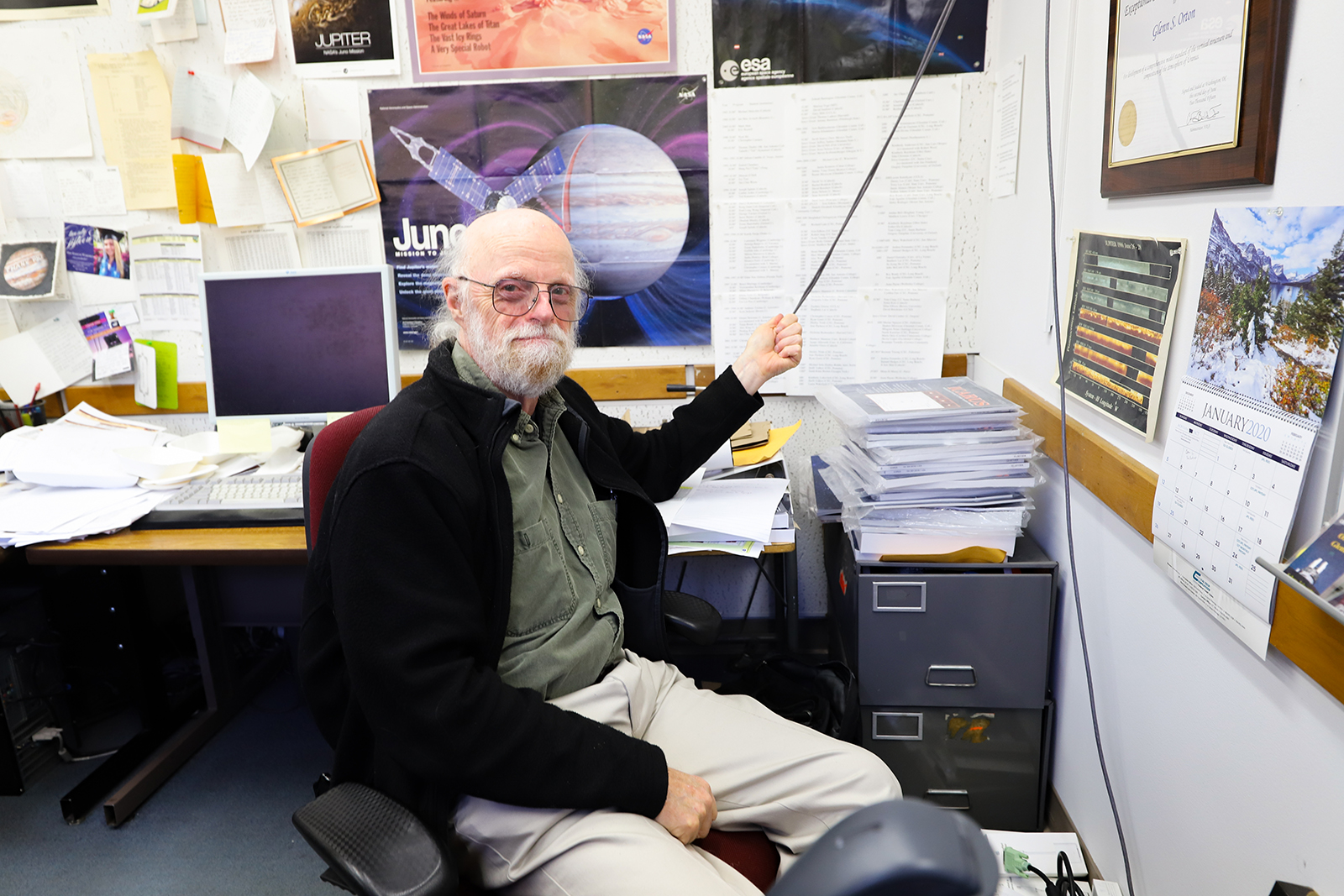
Planetary scientist Glenn Orton points to the list of more than 200 interns he's brought to JPL since 1985. Image Credit: NASA/JPL-Caltech | + Expand image
It makes one wonder what he could need that many students to do – until he takes out another paper listing the 11 projects in which he's involved.
"I think I probably have the record for the largest number of [projects] at JPL," says Orton, who divides his time between observing Jupiter with various ground- and space-based telescopes, comparing his observations with the ones made by NASA's Juno spacecraft, contributing to a database where all of the above is tracked and producing science papers about the team's discoveries.
"Often, you get to be the first person in the world who will know about something," says Orton. "That's probably the best thing in the world. The most exciting moment you have in this job is when you discover something."
Over the years, Orton's interns have been authors on science papers and have even taken part in investigating unexpected stellar phenomena – like the time when a mysterious object sliced into Jupiter's atmosphere, sparking an urgent whodunnit that had Orton and his team of interns on the case.
Orton says his passion for mentoring students comes from the lack of mentorship he received as a first-generation college student. At the same time, he acknowledges the vast opportunities he was given and says he wants students to have them, too.
"As a graduate student, it was close to my first experience doing guided research, so I had no idea how research was communicated or conducted," says Orton of his time at Caltech, when he often worried that his classmates and professors would discover he wasn't "Nobel material." "I want to be able to work with students, which I sincerely enjoy, to instruct them on setting down a research goal, determining an approach, modifying it when things inevitably hit a bump, as well as communicating results and evaluating next steps."
For Alexandra Holloway and Krys Blackwood, the chance to provide new opportunities isn't just what drives them to be mentors, but also something they look for when choosing interns.
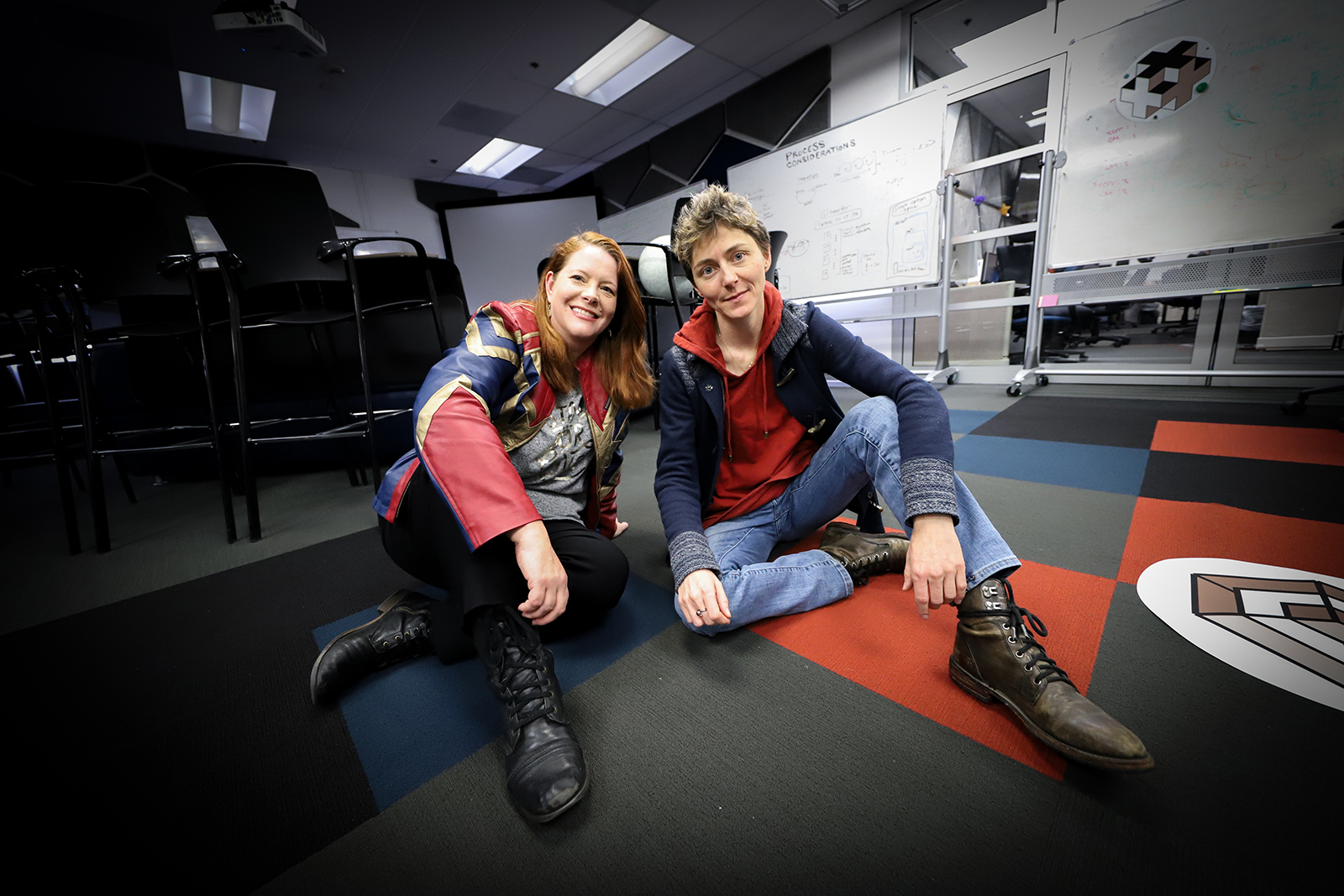
Krys Blackwood (left) and Alexandra Holloway work as a team to mentor students on projects that bring a human focus to robotic technology. Image Credit: NASA/JPL-Caltech | + Expand image
"I look for underdogs, students who are not representing themselves well on paper," says Holloway. "Folks from underrepresented backgrounds are less likely to have somebody guide them through, 'Here's how you make your résumé. Here's how you apply.' The most important thing is their enthusiasm for learning something new or trying something new."
It's for this reason that Holloway and Blackwood have become evangelists for JPL's small group of high-school interns, who come to the Laboratory through a competitive program sponsored by select local school districts. While less experienced than college students, high-school interns more than make up for it with perseverance and passion, says Blackwood.
"[High-school interns] compete to get a spot in the program, so they are highly motivated kids," she says. "Your results may vary on their level of skill when they come in, but they work so hard and they put out such great work."
Holloway and Blackwood met while working on the team that designs the systems people use to operate spacecraft and other robotic technology at JPL – that is, the human side of robotics. Holloway has since migrated back to robots as the lead software engineer for NASA's next Mars rover. But the two still often work together as mentors for the students they bring in to design prototypes or develop software used to operate rovers and the antennas that communicate with spacecraft across the solar system.
It's important to them that students get a window into different career possibilities so they can discover the path that speaks to them most. The pair say they've seen several students surprised by the career revelation that came at the end of their internships.
"For all of our interns, we tailor the project to the intern, the intern's abilities, their desires and which way they want to grow," says Holloway. "This is such a nice place where you can stretch for just a little bit of time, try something new and decide whether it's for you or not. We've had interns who did design tasks for us and at the end of the internship, they were like, 'You know what? I've realized that this is not for me.' And we were like, 'Awesome! You just saved yourself five years.'"
The revelations of students who intern with Parag Vaishampayan in JPL's Planetary Protection group come from something much smaller in scale – microscopic, even.
Vaishampayan's team studies some of the most extreme forms of life on Earth. The group is trying to learn whether similar kinds of tough microbes could survive on other worlds – and prevent those on Earth from hitching a ride to other planets on NASA spacecraft. An internship in Planetary Protection means students may have a chance to study these microbes, collect samples of bacteria inside the clean room where engineers are building the latest spacecraft or, for a lucky few, name bacteria.
"Any researcher who finds a new kind of bacteria gets a chance to name it," says Vaishampayan. "So we always give our students a chance to name any bacterium they discover after whoever they want. People have named bacteria after their professors, astronauts, famous scientists and so forth. We just published a paper where we named a bacterium after Carl Sagan."
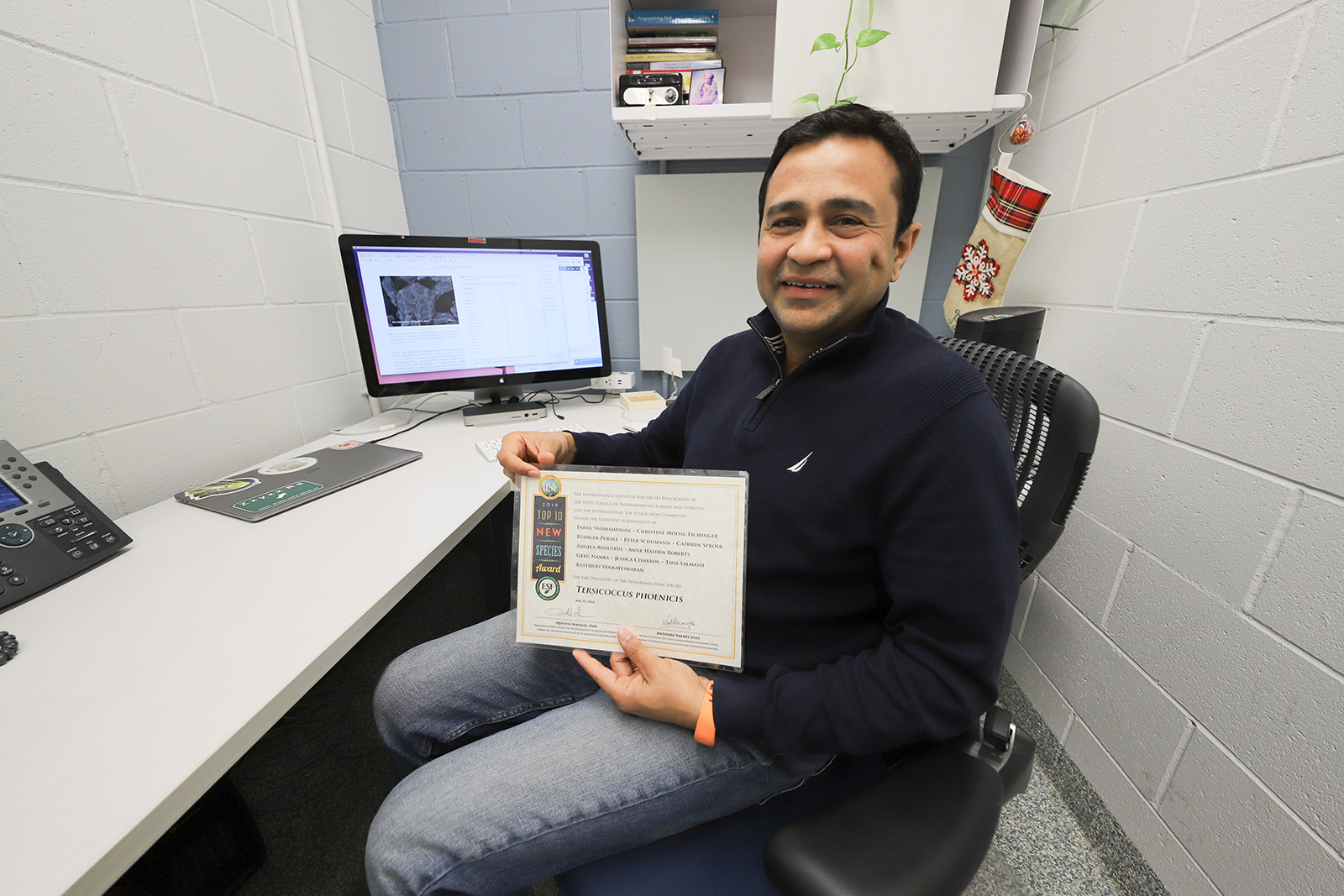
Students who intern with Parag Vaishampayan in JPL's Planetary Protection group might have a chance to name bacteria. Here, Vaishampayan holds an award he and his team (including several interns) received for their discovery of a bacterium they named Tersicoccus phoenicis. Image Credit: NASA/JPL-Caltech | + Expand image
The Planetary Protection group hosts about 10 students a year, and Vaishampayan says he's probably used every JPL internship program to bring them in. Recently, he's become a superuser of one designed for international students and another that partners with historically black colleges and universities, or HBCUs, to attract students from diverse backgrounds and set them on a pathway to a career at the Laboratory.
"I can talk for hours and hours about JPL internships. I think they are the soul of the active research we are doing here," says Vaishampayan. "Had we not had these programs, we would not have been able to do so much research work." In the years ahead, the programs might become even more essential for Vaishampayan as he takes on a new project analyzing 6,000 bacteria samples collected from spacecraft built in JPL's clean rooms since 1975.
With interns making up more than 15 percent of the Laboratory population each year, Vaishampayan is certainly not alone in his affection for JPL's internship programs. And JPL is equally appreciative of those willing to lend time and support to mentoring the next generation of explorers.
Says Adrian Ponce of those who take on the mentorship role through the programs his team manages, "Especially with this being National Mentoring Month, it's a great time to highlight the work of our thriving mentor community. I'd like to thank JPL mentors for their tremendous efforts and time commitment as they provide quality, hands-on experiences to students that support NASA missions and science, and foster a diverse and talented future workforce."
Explore JPL’s summer and year-round internship programs and apply at: jpl.nasa.gov/intern
Career opportunities in STEM and beyond can be found at: jpl.jobs
The laboratory’s STEM internship and fellowship programs are managed by the JPL Education Office. Extending the NASA Office of STEM Engagement’s reach, JPL Education seeks to create the next generation of scientists, engineers, technologists and space explorers by supporting educators and bringing the excitement of NASA missions and science to learners of all ages.
TAGS: Higher Education, Internships, Mentors, Research, Researchers, STEM, Interns, Juno, Jupiter, Science, Astrobiology, Planetary Protection, Computer Science, Design, Mentoring, Careers, Women at NASA
Edu News | February 28, 2013
JPL's Got One in the (Nerd) Game
It's Moogega Cooper's second Nerd War and she's in uncharted territory. She's been picked to play "Shadow Raven" in a fantasy story line about a "dark cult trying to resurrect an elder god." It's not that she's unaccustomed to playing a hero of sorts. As a planetary protection engineer at NASA's Jet Propulsion Laboratory in Pasadena, Calif., her job is quite literally to protect our planet and others in the solar system. It's just that this isn't her particular brand of nerd-dom -- yet.
This summer, Cooper took a break from her day job at JPL analyzing contamination risks for distant spacecraft and testing the might of extreme organisms to spend a month entrenched in a world of nerd dancing, extreme gaming and superhero debates as part of King of the Nerds, a reality competition show airing Thursday nights on TBS.
"It's a show that gets 11 nerds from across this nerd spectrum, which includes 'cosplay,' the people who do costume play, people who like comic books, scientists and engineers," said Cooper.
The nerds are pitted against each other in Survivor-style challenges, called Nerd Wars, with uniquely geeky twists, all while dealing with the often larger challenge of living under the same roof: a Pasadena, Calif., mansion dubbed "Nerdvana."
Cooper, who in the episode airing tonight is one of five finalists, says of the show that it was a test not just in smarts but in pure mental stamina. By the time the Nerd War got to her expertise in physics, "one plus one did not equal two at that point," she said.
Each of the self-proclaimed nerds have their specialties - Ivan is a video game developer, Celeste is a gamer, Danielle is an internet star and Genevieve is a Batman fangirl -- that come into play through the various team challenges and especially in the drama in Nerdvana. Cooper (who said she would avoid the drama by sneaking off to do puzzles) gets her nerd chops from her background and work in astrophysics, which has fascinated her from an early age.
"The main thing that sparked my interest in science was Carl Sagan's Cosmos," said Cooper who also spent much of her young life in Hampton, Va., near NASA's Langley Research Center. "When we would go to the library, we would rent the videos. Because he had several, we would take one every week. And because of him and Stephen Hawking, I thought, I'm going to be an astrophysicist."
Cooper was quick to turn that thought into a reality, doubling up on high school classes during her summers so she could start her undergraduate work at Hampton University at the age of 16. She later scored a place at JPL as a NASA Harriett G. Jenkins Pre-doctoral Fellow studying the use of non-equilibrium plasmas for spacecraft sterilization.
Now, at 27, she's switched to what she jokingly calls "the dark side" -- that is, engineering -- and spends her days working on various projects that involve keeping chemical or biological elements from hitching a ride on spacecraft and contaminating our planet (on returning to Earth) and other planets.
"The coolest part of my job is just having a new task to work on all the time," said Cooper. "I mean there's the same umbrella goal, but it manifests itself in either the test bed here or looking at the chemistry of a sample when it interacts with spacecraft hardware or playing with bacteria and seeing if we can kill it."
So while she's certainly got nerd cred, she also has one of the coolest jobs around. The question is whether she can survive the extreme environment of a house of nerds.
"It's kind of like moving back home, where you know there are
people that you have to live with and you can't really escape," said
Cooper. "There were times when the personalities didn't quite mesh
together completely but because we eventually got to learn about each
other and what makes us the way we are, everybody was just family."
TAGS: Women in STEM, King of the Nerds, TV, Engineering, Science, Planetary Protection, Women in STEM, Black History Month




